Cambodia
Temples of Angkor
Banteay Kdei
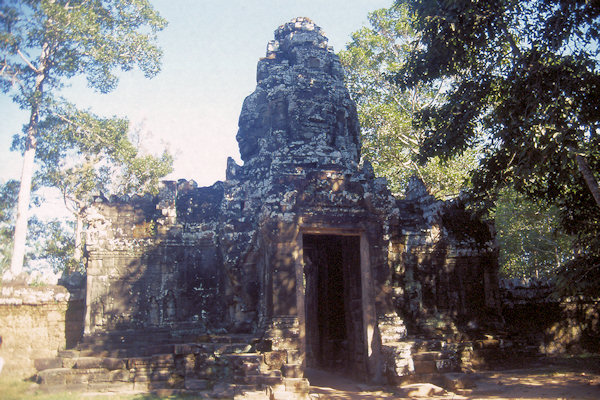 |
|||||
Banteay Kdei was built as a Buddhist monastic complex by Jayavarman VII (reigned 1181 - 1220) and was undoubtedly
an important temple. Today however, it is difficult to preceive what Banteay Kdei might have looked like because of its dilapidated
condition, due largely to faulty construction and the use of poor quality sandstone which has a tendency to crumble.
Nevertheless, it is worth a visit as it has some good carvings and is less crowded than other monuments of the same period.
The original basic plan included a central sanctuary, a surrounding gallery and a passageway connected to another gallery.
A moat enclosed the temple, another enclosure is made of laterite and has four gopuras in the Bayon style, each with four faces looking
in the cardinal directions.
A path leads from the east gopura to a grand rectangular terrace that is known as "The Hall of the Dancing Girls", a name derived
from the decoration, which includes a frieze of dancers.
Prasat Kravan
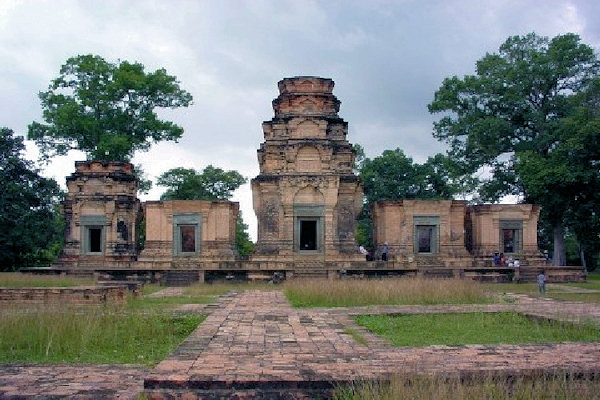 |
|||||
Prasat Kravan consists of five brick towers in a row on one platform, which are decorated with carved, sandstone lintels
and columns.
Prasat Kravan was built for Hindu worship in 921. The stucture is unusual in that it was not constructed by royalty but by high court
officials.
The central tower is the only tower with intact recessed tiers, which are visible on the interior.
It comprises a standing image of Vishnu (with four arms) carrying his attributes - a disc, a ball, a conch and a club.
On the right, Vishnu on the shoulders of a garuda stands between two worshippers.
Facing, Vishnu (with eight arms) is framed with six registers of people meditating and a giant lizard across the top.
The north Tower was dedicated to Laksmi, consort of Vishnu.
Her four hands hold her symbols of power and she is flanked by kneeling admires; the niche is decorated with tassels and floral swags.
Other Temples
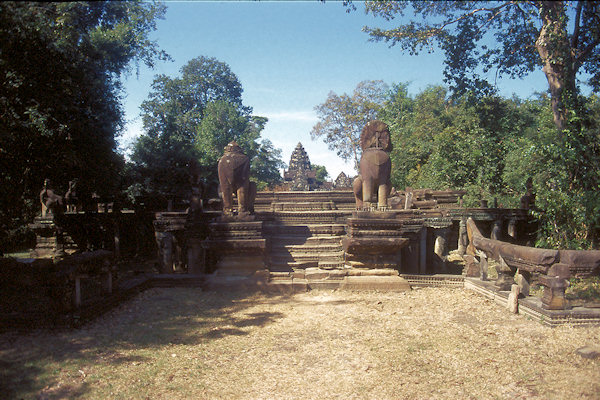 |
|||||
Banteay Samre
Banteay Samre was built by Suryavarman II (reigned 1112 - 1152).
The temple is in a fairly healthy state of preservation due to some extensive renovation work, although its isolation has resulted in
some devastating looting over the past two decades.
Phnom Bakheng
Soon after Yasovarman I (reigned 889 - 910) became king, he decided to move the capital north-west from Roluos, where his
predecessor reigned, to the area known today as Angkor. He named his new capital Yasodharapura and built Bakheng as his state
temple.
The main attraction however of Phnom Bakheng is the sunset view of Angkor Wat. Unfortunately, and inevitably, this affair has turned
into something of a circus, with crowds of tourists gasping up the steep slope of the hill, pestered all the way by nimble-footed
soft-drink vendors. So go there at day-time; it's worth it.
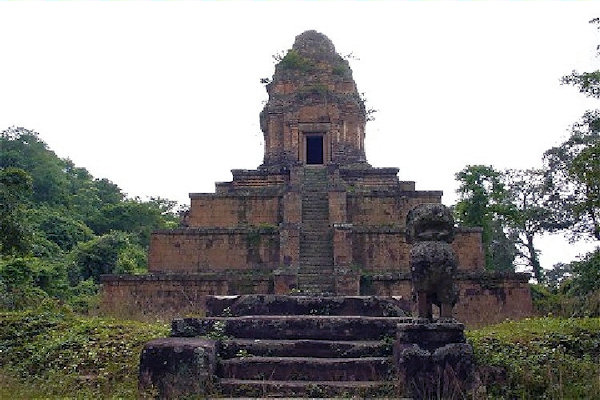 |
|||||
Baksei Chamkrong
The name of the temple derives from a legend in which the king fled during an attack on Angkor and was saved from being caught by the
enemy when a large bird swooped down and spread its wings to shelter him.
Baksei Chamkrong was built in the middle of the 10th century and was the first temple-mountain at Angkor built entirely of durable
materials - brick and laterite with sandstone decorations.
Ta Keo
Ta Keo is a stark, undecorated temple that undoubtedly would have been one of the finest of all Angkor's structures had it been finished.
Built by Jayavarman V (reigned 968 - 1001), it was dedicated to Shiva and was the first Angkorian monument built entirely
of sandstone.
No one is certain why work was never completed, but a likely cause may have been the death of the king.
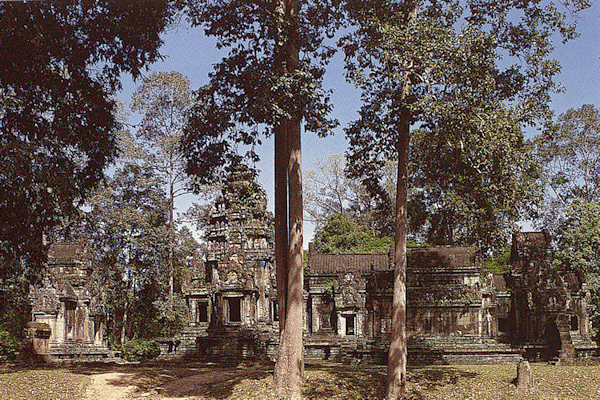 |
|||||
Chau Say Tevoda
Chau Say Tevoda and Tommanon are two small monuments, just outside the East (Victory) Gate of Angkor Thom. Because of similarities in
plan and form they are often referred to as the brother-sister temple.
It was probably built during the second quater of the 12th century and dedicated to Shiva and Vishnu.
Thommanon
Thommanon is just north of Chau Say Tevoda. Although unique, the temple complements its neighbour, as it was built around the same time
to a similar design.
Spean Thma
Spean Thma ("Bridge of Stone") of which an arch and several piers remain is 200, east of Thommanon. Jayavarman VII, the
last great builder of Angkor, constructed many roads with these immense stone bridges spanning watercourses, but this is the only
large bridge remaining in the immediate vicinity of Angkor.
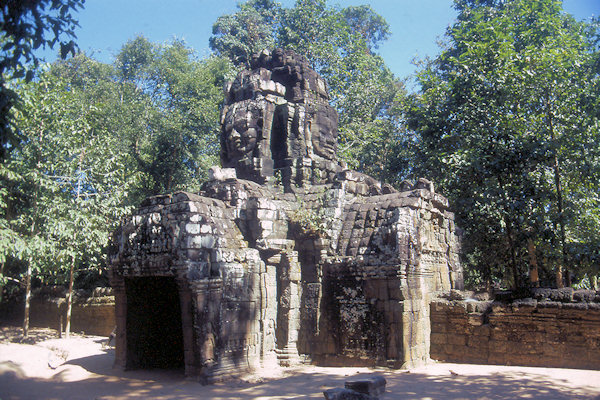 |
|||||
Ta Som
Ta Som is a small, quiet temple and affords a delightful undisturbed visit. It was buit by Jayavarman VII at the end of the
12th century.
A significant feature of Ta Som is the growth of a huge ficus tree on the east gopura, which provides a dramatic example of nature and
art entwined.
Ta Som is a single shrine on one level surrounded by three laterite enclosure walls. There are gopuras on the east and west side, which
are cruciform in shape with a small room on each side and windows with balusters. The superstructures are caved wit four faces.
The main tower is cruciform shaped with four porches.
Ta Nei
One of the smaller Angkor Temples, Ta Nei was built under King Jayavarman VII in the late 12th century. Some scholars believe
that the temple was constructed as a hospital. It is now in a fairly ruined state and approached only via a track through the forest.
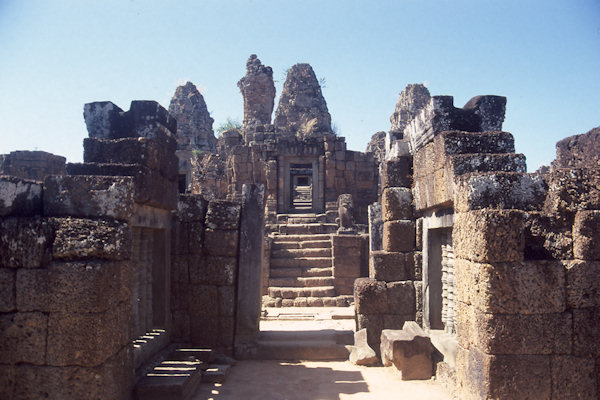 |
|||||
East Mebon
East Mebon, built by Rajendravarman II (reigned 944 - 968) once stood on a small island in the middle of the Eastern Baray, which
was a large body of water (2 by 7 kilometres) fed by the Siem Reap River.
The only access was by boat to one of the four landing-platforms, situated at the mid-points on each of the four sides of the temple.
Today, the baray is a plain of rice fields.
Preah Rup
Preah Rup was built in the second half of the 10th century by king Rajendravarman II (reigned 944 - 968) and was dedicated to
the god Shiva.
The Cambodians have always regarded this temple as having funary associations, but its true function is uncertain. Nevertheless, the
name Preah Rup recalls one of the rituals of cremation, in which the silhouette of the body of the deceased, outlined with its ashes,
is successively represented according to different orientations.
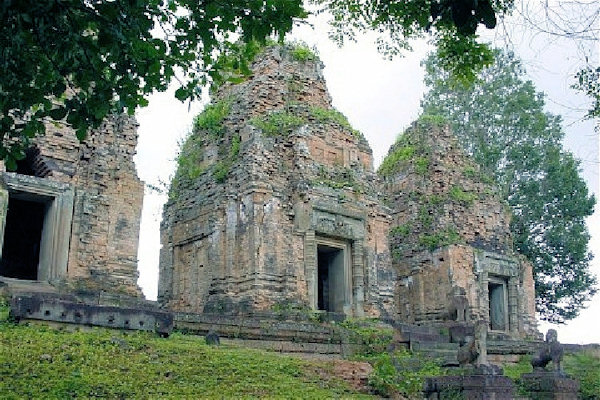 |
|||||
Bat Chum
This is a small temple built by Kavindrarimathana, a learned Buddhist minister of khmer king Rajendravarman II, at the
middle of the 10th century.
Prasat Prei
Prasat Prei, meaning the "Sanctuary of the Forest", is a 12th century temple built by King Jayavarman VII.
The temple is extremely small, with an outer enclosure measuring about 20 x 24 meters. Inside it comprises a central cruciform sanctuary
and a single "library" to the east.
Srah Srang
Srah Srang, "The Royal BathIt was dug in the mid-10th century, by initiative of Kavindrarimathana, Buddhist minister
of king
Rajendravarman II.
It was later modified around the year 1200 by Jayavarman VII, who also added the laterite landing-stage at its western side.